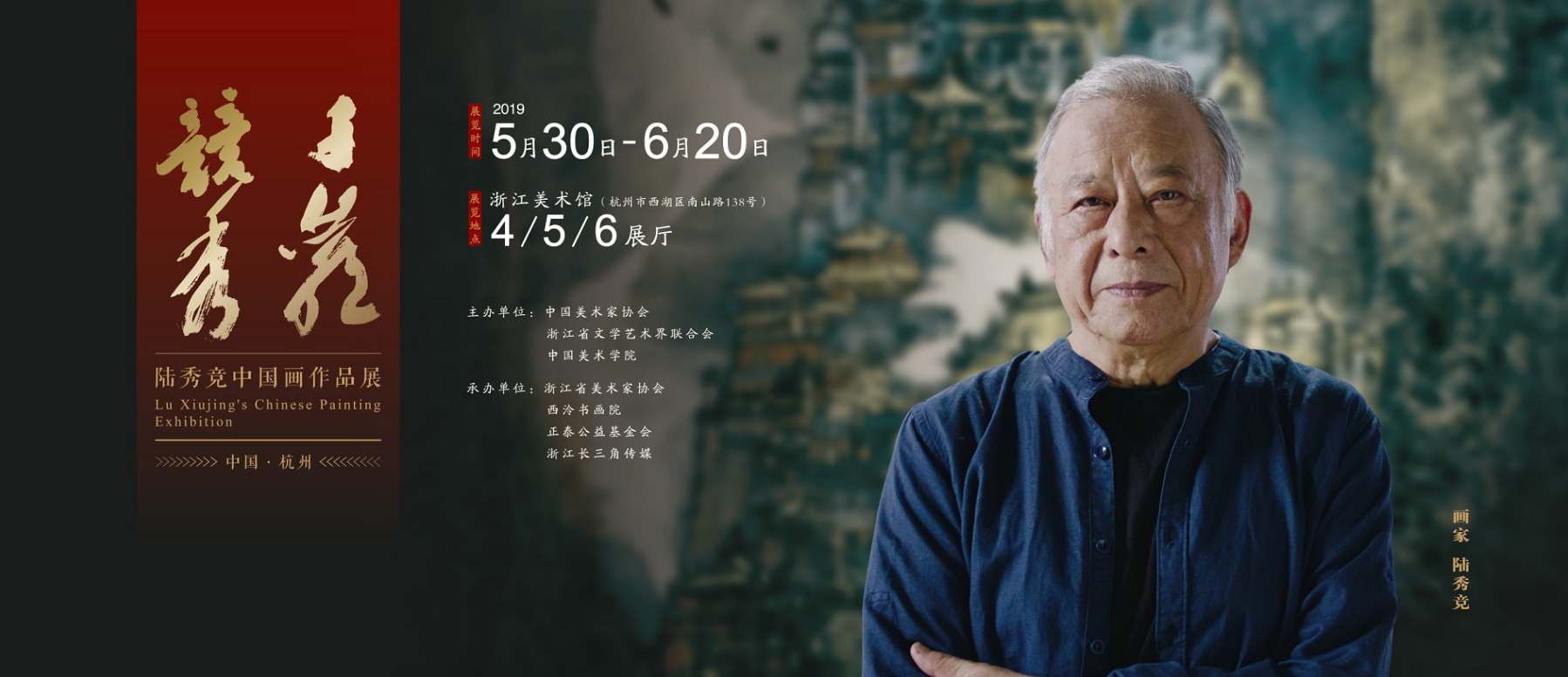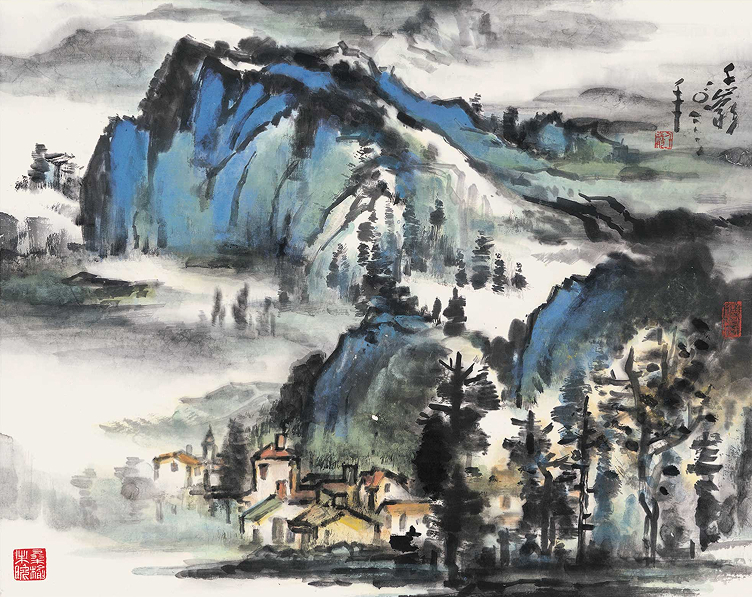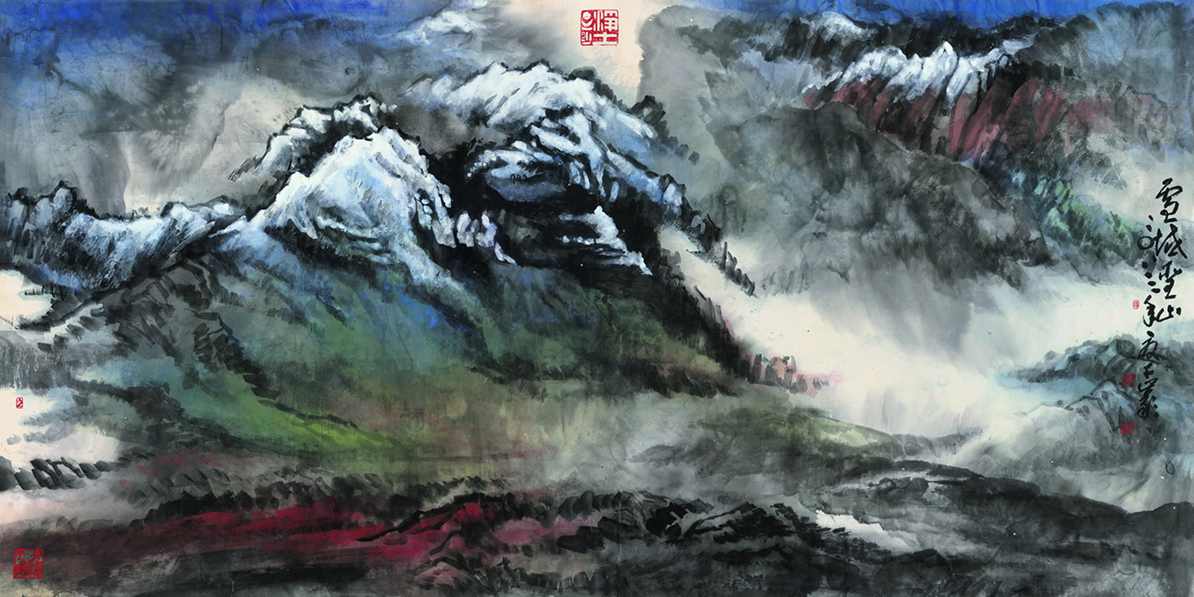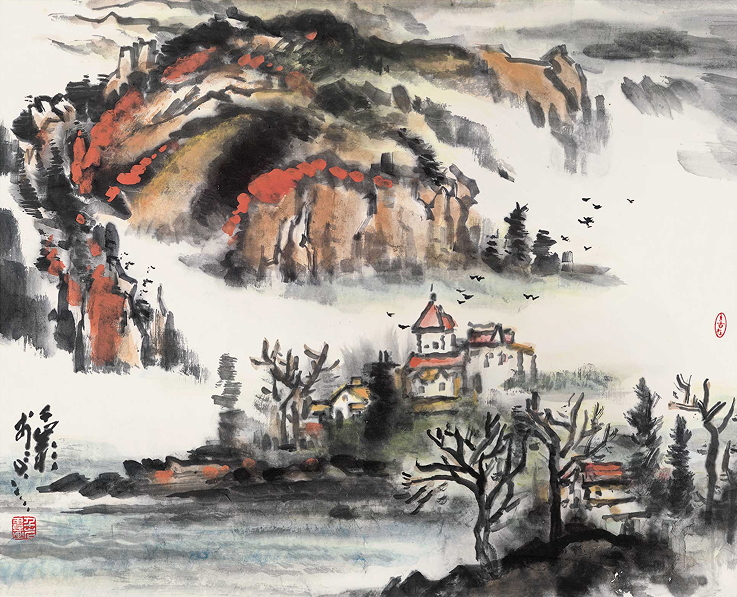On June 5, 2019, "A Thousand Peaks in Competition- – Lu Xiujing's Exhibition of Chinese Paintings" grandly opened at the Zhejiang Art Museum. "Painting is like a dream of returning home" – Lu Xiujing, a Zhejiang School landscape painter approaching his eightieth year, presented nearly a hundred works in his first solo exhibition in his hometown of Zhejiang, showing his fellow townsmen his life of painting landscapes that has spanned more than half a century.
Born and raised in Zhejiang, Mr. Lu felt a "timidness upon returning to one’s hometown" about hosting this exhibition in Hangzhou. He acknowledges being intimately familiar with Zhejiang’s landscapes, just as the province’s art circle knows him well. To him, this felt like a "review" of his achievements in Chinese painting by "one of their own."Indeed, this exhibition stands as the fruit of decades of Mr. Lu’s dedication—honing his brushwork, scaling artistic peaks, and building upon tradition to achieve greater refinement. Lu Xiujing chuckled, "I’ve painted countless works, practicing diligently day in and day out. Now I’ve picked out the finest, the most meaningful ones, to share with everyone."
At the opening ceremony, Xu Xiao, member of the Party Leadership Group and Secretary of the Secretariat of the Zhejiang Federation of Literary and Art Circles, stated in his speech that painter Lu Xiujing's creations embody his distinctive personal characteristics and innovative thinking. He has inherited and carried forward the fine traditions of Zhejiang School landscape painting, while also creating a creative style with rich coloring and unique personal features, which fully reflects the spirit of the times and the artist's constantly evolving artistic journey. Lu Xiujing's achievements in theoretical research and teaching practice have further dedicated his efforts and contributed results to the prosperity and development of Chinese art and Zhejiang art.
At the opening ceremony, Du Gaojie, a professor at Zhejiang University, fondly recalled his early interactions and collaborative experiences with artist Lu Xiujing, and spoke highly of Mr. Lu's artistic achievements. Du Gaojie noted, "I have known Brother Xiujing for decades, and I believe he has blazed a distinct artistic path with a unique style in Chinese painting creation. His diverse accomplishments can be seen through his works of different themes. The first category of iconic works depicts Tibetan landscapes. In the 1990s, after returning from Xinjiang and Tibet, he created works that combine splashed ink and color with a romantic flair. Even today, those works remain incredibly appealing in both their appearance and style. The second category comprises his water town paintings, which fully embody an aesthetic of Chinese painting—*the beauty lies in the balance between resemblance and non-resemblance*. With lines as the main element, he has constructed the scenery of Jiangnan water towns. The third category includes his recent works. Based on ink-wash, he has extensively employed vibrant colors, dots, and lines, seamlessly integrating traditional Chinese techniques with certain Western modern expressive methods. Rooted in profound traditions, he has incorporated Western elements into Chinese painting."
At the opening ceremony, painter Lu Xiujing said, "Painting is just like a dream of returning home. I graduated from the China Academy of Art and have been closely connected with Hangzhou all my life. Whether it is from school to society, from the south of the Yangtze River to the north, or from domestic to international, the landscapes of my hometown and the mountains and rivers of the motherland are unforgettable to me all my life. Without the personal guidance and earnest teachings of Mr. Lu Yanshao, Mr. Lu Weizhao and other masters, I would not have achieved what I have today. Moreover, the care and cultivation from my family and teachers in the art circle make me feel extremely honored and deeply grateful from the bottom of my heart. I have been diligently pursuing the essence of brush and ink, and in recent years, I have also made some reflections and practices on the colors of Chinese painting. The idea of 'seeking excellence in ink first' means establishing the ink framework before applying colors. Inheriting and innovating to build a new painting art is a long and arduous task. I stick to my own path and create my own style, but there are also many problems. Through this exhibition, I hope to gain more insights and guidance."At the opening site, Ying Jinfei, curator of the Zhejiang Art Museum, presented a donation certificate to Mr. Lu Xiujing in appreciation of his generous donation of the huge color ink landscape painting “Empty Mountains in Clear Autumn”to the Zhejiang Art Museum.
In his speech, Ge Xuebin, Vice Minister of the Publicity Department of the Zhejiang Provincial Party Committee, stated that having artists like Lu Xiujing, with such passion for artistic creation and dedication to presenting fine artistic works, is a significant contribution to the development of Zhejiang's cultural undertakings and the building of a culturally strong Zhejiang.
In addition to featuring most of the works from Mr. Lu Xiujing's large-scale solo exhibition at the National Art Museum of China last year, this exhibition also showcases his "innovative works" created in recent years. Through three themed exhibition halls – "Breaking Barriers for Connectivity", "Boundless Horizons" and "A Panoramic View of Lakes and Mountains" – combined with special research, the exhibition vividly and profoundly outlines Lu Xiujing's artistic life, creative journey and cultural pursuit spanning more than 50 years from the 1960s to the present. It allows viewers to see the world, see all beings, and see themselves.
In the themed exhibition hall "Breaking Barriers for Connectivity", works ranging from depictions of the vast deserts and gobi of Xinjiang and the Mogao Grottoes in Dunhuang to scenes of Yandang Mountain and Huangshan Mountain present the artist's exploration of drawing strength and inspiration for the innovation and modern transformation of Chinese painting from sketching in border areas during his journey of measuring the land of China with his footsteps. Lu Xiujing was captivated by this pursuit and devoted all his efforts to it. Through the language of heavy-color splashed ink, he creates magnificent yet profound artistic conceptions. The vast momentum of the northwest endowed him with new strength, bringing forth grand and lofty compositions and implications; the ethnic art of the northwest also provided him with brand-new inspiration for the color system and techniques in his creations. Such a cumulative effect gradually enabled Lu Xiujing's works to break away from the early regional features of the Jiangnan area, thus expanding his footsteps and horizons to a national perspective, and pondering new possibilities for the development of Chinese painting in the contemporary era.
If the imagery of northwest China brought about a transformation in Lu Xiujing’s artistic creative approach, his travel experiences and visual encounters abroad further deepened this shift. The theme "Boundless Horizons" emphasizes the artist’s cross-border travel experiences and his efforts to integrate Chinese and Western art, showcasing his visual perceptions and artworks developed during his sojourns overseas, particularly in North America.Grasping cross-cultural artistic styles infused Lu Xiujing’s creations with vitality, which once again altered his artistic thinking and style. All the rich impressions he gained from traveling around the world converged into the instant spread of ink and wash on rice paper.
The title of the themed section "A Panoramic View of Lakes and Mountains" is derived from a masterpiece by Lu Yanshao, a master of modern Chinese painting, and also represents a major artistic style of Lu Xiujing. Under this theme, the exhibition focuses on demonstrating how the landscape works created by the artist inherit and carry forward the artistic traditions of Zhejiang School landscape painting.There are quite a number of works by Lu Xiujing featuring the timeless, magnificent, elegant and simplistic style of "small green landscape" or "light crimson landscape" coloring techniques. In many of his panoramic landscape paintings, the profound influence of modern Chinese landscape painting—especially that of the modern Zhejiang School and Shanghai School—can be clearly perceived. Lu Xiujing has transformed the distinctly Jiangnan-style water town scenery into more profound panoramic landscape works, which embody stronger humanistic feelings and characteristics of literati painting, thereby presenting another facet of the landscapes in southern China.
At the exhibition venue thronged with visitors, the audience was deeply moved by Lu Xiujing’s art. Just as Xu Jiang, President of the China Academy of Art, commented: “After decades of refinement by Mr. Lu Xiujing, the way of using the brush in Chinese landscape painting has demonstrated a unique artistic vision, along with an immersive and transcendent quality that is profound and imposing.”
For those who paint landscapes, being accompanied by such cultural peaks is truly a spiritual blessing. Throughout his life, Mr. Lu Xiujing has traversed countless mountains and rivers—not only visiting famous mountains across northern and southern China, but also traveling far across oceans to distant continents. He has integrated perspectives on landscapes from both Eastern and Western cultures, making him not only an unbounded explorer in contemporary landscape painting, but also a person who finds joy in the inspiration and nourishment derived from rivers and mountains.
With overlapping mountain ranges and winding streams, many of his landscape works exude a coherent and continuous charm. It is as if he always stands at the edge of mountain clusters, looking across mountain banks to directly depict the landscapes through the four seasons and the swaying of mountains, plants, and trees from dawn to dusk. Driven by his brush and ink, he navigates through landscapes of winding mountains and rivers, as well as through misty clouds and mists, creating worlds permeated with dense clouds, sudden rains, light ink washes, and faint mountain mists. He not only uses this perspective to paint the southern mountains and northern plains, but also the deep canyons and vast valleys on the American continent. Through this pure, poetic way of seeing, he has embraced boundless rivers and mountains. In turn, these landscapes—with the hazy aura of twilight and evening mists—have refined his brushwork and forged his broad mind. Those endless rivers and mountains, with their ever-renewing manifestations, have shaped the endless rolling hills and valleys in his paintings and in his heart.





